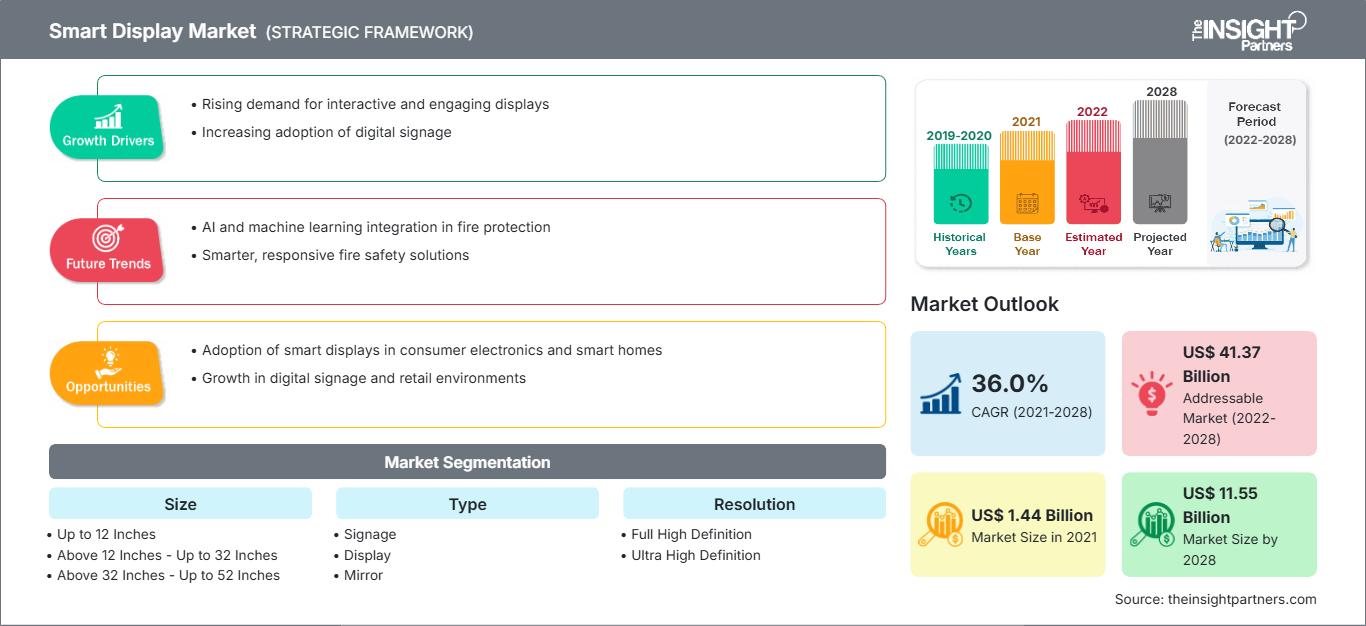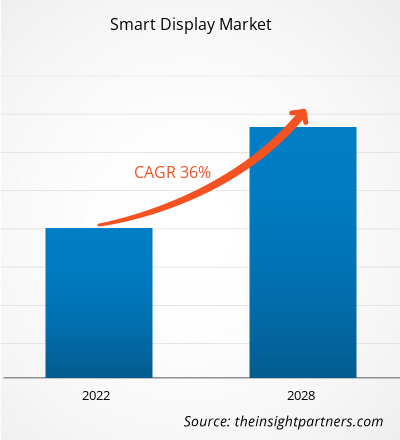Le marché des écrans intelligents était évalué à 1 443,74 millions de dollars américains en 2021 et devrait atteindre 11 547,23 millions de dollars américains d'ici 2028 ; son TCAC devrait atteindre 36,0 % entre 2022 et 2028.
Un écran intelligent est un affichage numérique qui peut être commandé à l'aide de télécommandes vocales ou d'appareils connectés à l'Internet des objets (IoT). Par exemple, un miroir intelligent est un appareil innovant qui enregistre les informations personnelles des utilisateurs et l'expérience des acheteurs dans les secteurs de l'automobile et de la vente au détail. De plus, en tant que solution technique de pointe, l'écran intelligent comprend des fonctions de contrôle interactives et complexes.
La forte demande de rétroviseurs intelligents de la part de l'industrie automobile, les fonctionnalités nouvelles et innovantes offertes par les rétroviseurs intelligents, le nombre croissant d'internautes et l'adoption croissante d'appareils intelligents en fonction des préférences des consommateurs, la demande croissante d'appareils électroménagers intelligents alimentés par l'IA et l'IoT, la tendance croissante à la signalisation contextuelle et l'adoption croissante de la signalisation intelligente dans le secteur de la vente au détail sont les principaux facteurs à l'origine de la croissance du marché des écrans intelligents.
La croissance du secteur de la vente au détail est soutenue par l'augmentation du pouvoir d'achat des consommateurs. De plus, l'expansion rapide des centres commerciaux et des espaces de vente dans le monde entier stimule la demande de solutions d'affichage intelligent pour attirer les passants et les encourager à entrer en magasin. Par conséquent, les magasins intelligents sont intéressés par la publicité programmatique pour accroître la notoriété de la marque. L'affichage intelligent peut également être utilisé dans le processus de paiement. Les clients peuvent payer avec un appareil mobile au lieu de faire la queue à la caisse. Plusieurs détaillants, tels que Walmart, Alibaba, Amazon et Carrefour, ont installé des magasins intelligents dans le monde entier. Ils utilisent diverses solutions et technologies de vente au détail intelligentes, comme l'affichage intelligent, dans leurs magasins connectés. Partout dans le monde, les détaillants ont mis en œuvre des stratégies d'expansion et de partenariat pour ouvrir des magasins plus intelligents et sans caisse. Tous ces facteurs stimulent le marché de l'affichage intelligent.
Vous bénéficierez d’une personnalisation sur n’importe quel rapport - gratuitement - y compris des parties de ce rapport, ou une analyse au niveau du pays, un pack de données Excel, ainsi que de profiter d’offres exceptionnelles et de réductions pour les start-ups et les universités
Marché des écrans intelligents: Perspectives stratégiques

- Obtenez les principales tendances clés du marché de ce rapport.Cet échantillon GRATUIT comprendra une analyse de données, allant des tendances du marché aux estimations et prévisions.
Analyse du marché des écrans intelligents
Présence de marques populaires
Une fois que les clients se sont habitués au produit d'une marque particulière, ils en achètent d'autres. Certaines marques bien connues, telles que Google ; Amazon, Inc. ; Bosch ; Panasonic ; BenQ Corporation ; LG Electronics ; Lenovo Group, Ltd. ; Samsung Corporation ; et Sony Corporation, proposent diverses solutions d'écrans intelligents pour les secteurs de l'automobile, de la santé, du résidentiel et du commerce de détail. Ces marques attirent facilement leurs clients fidèles et constituent un moteur majeur de la croissance du marché des écrans intelligents. Les marques font parfois la promotion de leurs produits avant leur lancement afin de créer un engouement auprès des clients. Par exemple, en mars 2022, l'écran intelligent Xiaomi 10 a été répertorié sur plusieurs sites web et le produit a été lancé en avril 2022. En janvier 2022, Google a lancé son écran intelligent Google Nest Hub de 2e génération en Inde au prix de 103,24 USD. En juin 2021, Amazon a lancé deux nouveaux écrans intelligents sur le marché indien : les Echo Show 10 et 5. La popularité croissante de ces marques stimule la croissance du marché des écrans intelligents.
Analyse du marché par taille
Selon la taille, le marché des écrans intelligents est segmenté en jusqu'à 12 pouces, plus de 12 pouces – jusqu'à 32 pouces, plus de 32 pouces – jusqu'à 52 pouces, et plus de 52 pouces. Les tailles d'écran varient d'un fabricant à l'autre. Si certains fabricants offrent des fonctionnalités supérieures même sur des écrans plus petits, d'autres préfèrent varier les fonctionnalités en fonction de la taille de l'écran. Le marché est principalement porté par la demande croissante d'écrans d'affichage intelligents de taille moyenne dans divers secteurs verticaux à l'échelle mondiale.
Analyse du marché par résolution
Selon la résolution, le marché des écrans intelligents est segmenté en Full High Definition (FHD), Ultra High Definition (UHD) et autres. Les écrans intelligents avec une résolution HD sont principalement utilisés pour les applications résidentielles. Cependant, la plupart des autres applications, comme l'affichage publicitaire ou les bornes intelligentes, utilisent de plus en plus d'écrans aux résolutions UHD et FHD. Le marché est principalement porté par la demande croissante d'écrans d'affichage intelligents offrant une meilleure résolution, permettant aux utilisateurs de profiter d'une expérience immersive.
Les acteurs du marché des écrans intelligents adoptent des stratégies telles que les fusions, les acquisitions et les initiatives commerciales pour maintenir leurs positions. Voici quelques développements des principaux acteurs du marché :
- L'application d'affichage dynamique Android NoviSign est actuellement disponible pour tous les écrans Sony BRAVIA Professional Android, selon NoviSign, leader du secteur et pionnier de l'affichage dynamique Android. La gamme professionnelle BRAVIA de Sony prend en charge la 4K et le HDR, dispose d'une plateforme système sur puce et est disponible dans des tailles allant de 32 à 100 pouces.
- BenQ, leader des technologies d'affichage interactif, a rejoint l'Initiative de solutions intégrées pour l'éducation de Google. L'engagement de BenQ à fournir des solutions éducatives qui permettent aux écoles de construire des environnements d'apprentissage actif plus résilients adaptés à l'apprentissage en personne et à distance est maintenu en se joignant à cet effort.
Aperçu régional du marché des écrans intelligents
Les tendances régionales et les facteurs influençant le marché des écrans intelligents tout au long de la période de prévision ont été analysés en détail par les analystes de The Insight Partners. Cette section aborde également les segments et la géographie du marché des écrans intelligents en Amérique du Nord, en Europe, en Asie-Pacifique, au Moyen-Orient et en Afrique, ainsi qu'en Amérique du Sud et en Amérique centrale.
Portée du rapport sur le marché des écrans intelligents
| Attribut de rapport | Détails |
|---|---|
| Taille du marché en 2021 | US$ 1.44 Billion |
| Taille du marché par 2028 | US$ 11.55 Billion |
| TCAC mondial (2021 - 2028) | 36.0% |
| Données historiques | 2019-2020 |
| Période de prévision | 2022-2028 |
| Segments couverts |
By Taille
|
| Régions et pays couverts | Amérique du Nord
|
| Leaders du marché et profils d'entreprises clés |
|
Densité des acteurs du marché des écrans intelligents : comprendre son impact sur la dynamique des entreprises
Le marché des écrans intelligents connaît une croissance rapide, portée par une demande croissante des utilisateurs finaux, due à des facteurs tels que l'évolution des préférences des consommateurs, les avancées technologiques et une meilleure connaissance des avantages du produit. Face à cette demande croissante, les entreprises élargissent leur offre, innovent pour répondre aux besoins des consommateurs et capitalisent sur les nouvelles tendances, ce qui alimente la croissance du marché.

- Obtenez le Marché des écrans intelligents Aperçu des principaux acteurs clés
- Analyse historique (2 ans), année de base, prévision (7 ans) avec TCAC
- Analyse PEST et SWOT
- Taille du marché Valeur / Volume - Mondial, Régional, Pays
- Industrie et paysage concurrentiel
- Ensemble de données Excel
Rapports récents
Rapports connexes
Témoignages
Raison d'acheter
- Prise de décision éclairée
- Compréhension de la dynamique du marché
- Analyse concurrentielle
- Connaissances clients
- Prévisions de marché
- Atténuation des risques
- Planification stratégique
- Justification des investissements
- Identification des marchés émergents
- Amélioration des stratégies marketing
- Amélioration de l'efficacité opérationnelle
- Alignement sur les tendances réglementaires




















 Obtenez un échantillon gratuit pour - Marché des écrans intelligents
Obtenez un échantillon gratuit pour - Marché des écrans intelligents